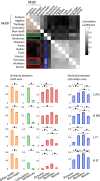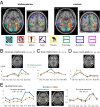Origins of the brain networks for advanced mathematics in expert mathematicians
- PMID: 27071124
- PMCID: PMC4983814
- DOI: 10.1073/pnas.1603205113
Origins of the brain networks for advanced mathematics in expert mathematicians
Abstract
The origins of human abilities for mathematics are debated: Some theories suggest that they are founded upon evolutionarily ancient brain circuits for number and space and others that they are grounded in language competence. To evaluate what brain systems underlie higher mathematics, we scanned professional mathematicians and mathematically naive subjects of equal academic standing as they evaluated the truth of advanced mathematical and nonmathematical statements. In professional mathematicians only, mathematical statements, whether in algebra, analysis, topology or geometry, activated a reproducible set of bilateral frontal, Intraparietal, and ventrolateral temporal regions. Crucially, these activations spared areas related to language and to general-knowledge semantics. Rather, mathematical judgments were related to an amplification of brain activity at sites that are activated by numbers and formulas in nonmathematicians, with a corresponding reduction in nearby face responses. The evidence suggests that high-level mathematical expertise and basic number sense share common roots in a nonlinguistic brain circuit.
Keywords: functional MRI; mathematical cognition; semantic judgment.
Conflict of interest statement
The authors declare no conflict of interest.
Figures








Comment on
-
The neural roots of mathematical expertise.Proc Natl Acad Sci U S A. 2016 May 3;113(18):4887-9. doi: 10.1073/pnas.1604758113. Epub 2016 Apr 19. Proc Natl Acad Sci U S A. 2016. PMID: 27095847 Free PMC article. No abstract available.
References
-
- Chomsky N. Language and Mind. Cambridge Univ Press; Cambridge, UK: 2006.
-
- Hadamard J. An Essay on the Psychology of Invention in the Mathematical Field. Princeton Univ Press; Princeton: 1945.
-
- Dehaene S. The Number Sense. 2nd Ed Oxford Univ Press; New York: 2011.
-
- Dehaene S, Izard V, Pica P, Spelke E. Core knowledge of geometry in an Amazonian indigene group. Science. 2006;311(5759):381–384. - PubMed
Publication types
MeSH terms
LinkOut - more resources
Full Text Sources
Other Literature Sources
Medical
Molecular Biology Databases

